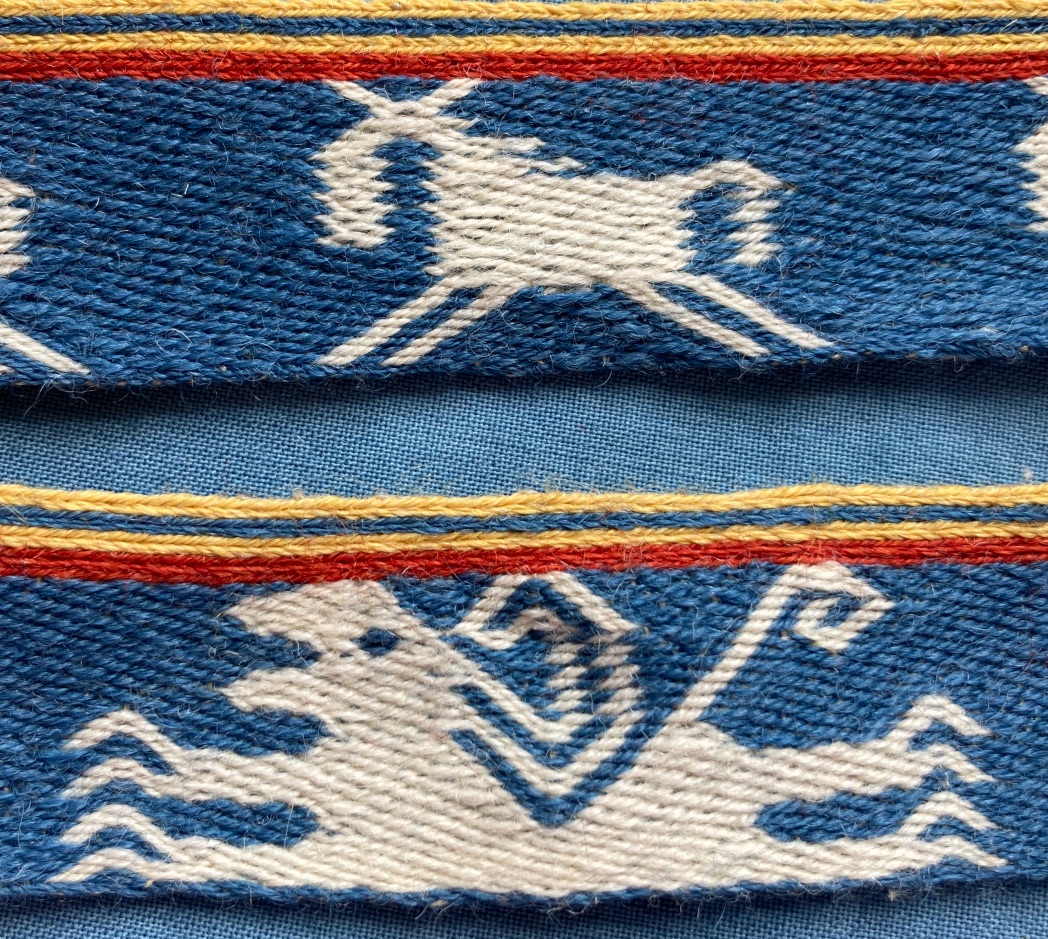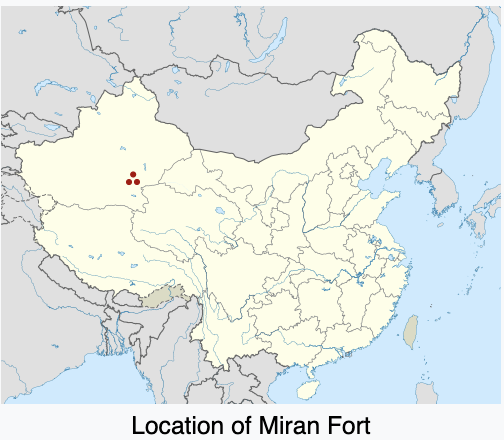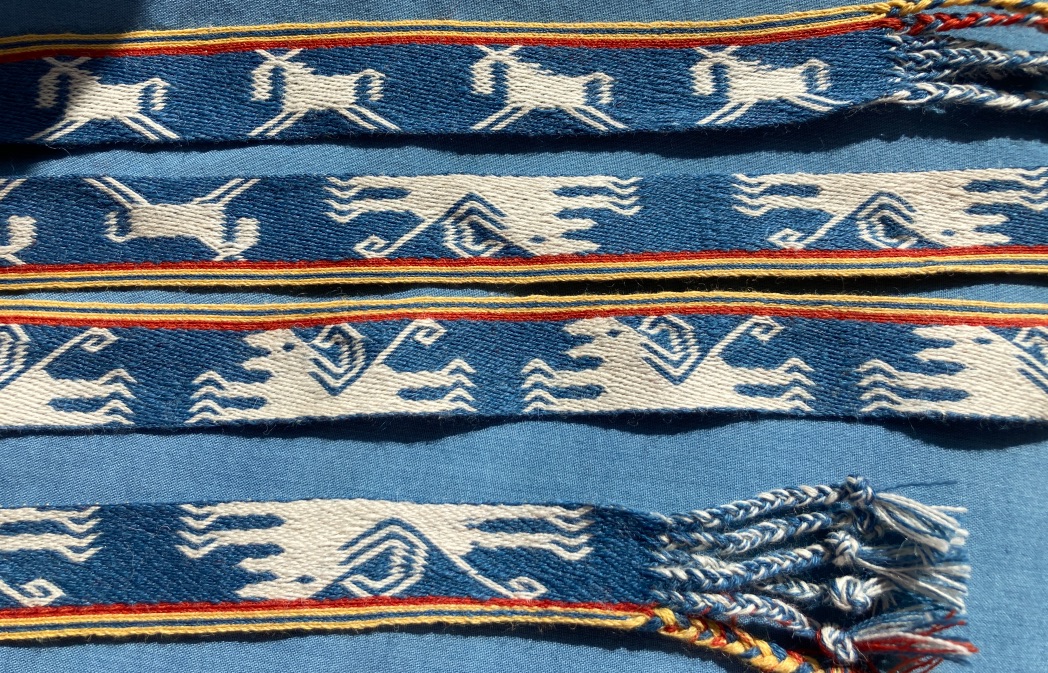
Die brettchengewebte Borte aus Miran Fort
Als Sir Marc Aurel Stein 1907 in Miran Fort, das am südöstlichen Rand der Taklamakan-Wüste an der Seidenstraße liegt, Müllhaufen ausgrub, fand er nicht nur frühe Beispiele tibetischer Schrift, sondern auch Textilfragmente, die auf das späte 8. Jahrhundert zurückgehen. Unter den Textilien befanden sich auch zwei zusammengenähte Bänder, die brettchengewebt waren. Die Bänder wurden mit insgesamt ca. 180 Brettchen gewebt und hatten eine Breite von mehr als 20 cm (7,9″).
Das breitere Band hat ein komplexes Flottierungsmuster (das Muster findet man in 'Kaartweeftechnieken patronen met Kettingflottering' von Marijke van Epen). Das schmalere Band ist das mit den Tiermotiven. Abgesehen von dem Band aus Evebø ist dies der einzige frühmittelalterliche Fund mit Tiermotiven, das ich kenne. Der Löwe ist gut bekannt, aber es gibt noch ein anderes Tier, das einem Pferd oder einem Maultier ähnelt. Das Band ist etwa 3,6 cm (1,2″) breit.
When in 1907 Sir Marc Aurel Stein excavated rubbish heaps at Miran Fort which is located at the southeastern edge of the Taklamakan Desert on the Silk Road, he not only found early examples of Tibetan writing but also textile fragments that date to the late 8th century. Among the textiles were two tablet woven bands that are sewn together. The bands were woven with a total of approx. 180 tablets and had a width of more than 20 cm (7.9″). The wider band has a complex floatwork pattern (you can find the pattern in Kaartweeftechnieken patronen met Kettingflottering by Marijke van Epen). The narrower one is the one with the animal motifs. Apart from the band from Evebø this is the only early medieval find with animal motifs. The lion is well known, but there is another animal that resembles a horse or a mule. The band is approximately 3.6 cm (1.2″) width.
The wider band has a complex floatwork pattern (you can find the pattern in Kaartweeftechnieken patronen met Kettingflottering by Marijke van Epen). The narrower one is the one with the animal motifs. Apart from the band from Evebø this is the only early medieval find with animal motifs. The lion is well known, but there is another animal that resembles a horse or a mule. The band is approximately 3.6 cm (1.2″) width.
Im Gegensatz zu den meisten Bändern, die mit Schafwolle gewebt sind, wurde dieses aus Yakwolle (weiß und gefärbt, aber es gibt keine Farbstoffanalyse) hergestellt. Die Technik ist 3/1 Köper. Lise Raeder Knudsen schätzt, dass es mit etwa 40 Brettchen gewebt worden sein muss.
Als ich das Muster für den Löwen fertiggestellt hatte, kam ich auf 28 Musterbrettchen und 9 Randbrettchen auf einer Seite und 1 Randbrettchen auf der anderen Seite. Es ist eines der Bänder, bei denen ich mich bemühe, sie so kompakt wie das Original zu weben, aber ohne Erfolg.

Unlike most bands, which are woven with sheep wool, this one was made of yak wool (white and dyed but there exists no dye analysis). The technique is 3/1 broken twill. Lise Raeder Knudsen estimated that it must have been woven with approximately 40 tablets.
When I finished figuring out the pattern for the lion, I came up with 28 pattern tablets and 9 border tablets on one side, and 1 border tablet on the other. It is one of the bands where I struggle to weave it as compact as the original but without success.
Noch schwieriger als der Löwe war es, das Pferdemuster herauszufinden, da die Fragmente dieses Teils des Fundes nicht so gut erhalten waren. Obwohl ziemlich viele Pferde gewebt wurden, bin ich mir nicht sicher, ob ich wirklich das richtige Muster habe.
Da ich keine Yakwolle hatte, habe ich Nm 20/2 Schafwolle verwendet und eine Breite von 2,7 cm (1,1″) erhalten, also war die Yakwolle gar nicht so dünn.
More difficult than the lion was figuring out the horse pattern, as the fragments of this part of the find were not of good quality. Although quite a lot of horses were woven, I’m not sure if I really have the right pattern.
As I didn’t have yak wool, I used Nm 20/2 sheep’s wool and got a width of 2.7 cm (1.1″), so the yak wool wasn’t that thin at all.

Eine Anleitung findet man hier. You can find the pattern here.
Literatur:
Collingwood, Peter. The Techniques of Tablet Weaving, Brattleboro, VT: Echo Point Books & Media, 2015.
Knudsen, Lise Raeder. Ancient Running Animals: Tablet-woven borders from China and Norway. Global Textile Encounters, edited by Marie Lousie Nosch, Zhao Feng and Lotika Varadarajan, Oxford: Oxbow Books, 2014, pp. 49-64.
Stein, Aurel, Serindia: Detailed Report of Exploration in Central Asia and Westernmost China Carried Out and Described Under the Orders of H.M Indian Government, Oxford: Clarendon Press, 1921, vol. I, p.478. Vol.IV, pl. XLVIII.
Marijke van Epen, Kaartweeftechnieken patronen met Kettingflottering, 2017
Homepage of the Victoria and Albert Museum, London
https://collections.vam.ac.uk/item/O91172/the-stein-collection-fragment-unknown/
https://collections.vam.ac.uk/item/O91168/the-stein-collection-fragment-unknown/
